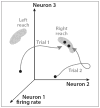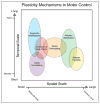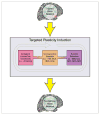Plasticity of Sensorimotor Networks: Multiple Overlapping Mechanisms
- PMID: 26985069
- PMCID: PMC5108685
- DOI: 10.1177/1073858416638641
Plasticity of Sensorimotor Networks: Multiple Overlapping Mechanisms
Abstract
Redundancy is an important feature of the motor system, as abundant degrees of freedom are prominent at every level of organization across the central and peripheral nervous systems, and musculoskeletal system. This basic feature results in a system that is both flexible and robust, and which can be sustainably adapted through plasticity mechanisms in response to intrinsic organismal changes and dynamic environments. While much early work of motor system organization has focused on synaptic-based plasticity processes that are driven via experience, recent investigations of neuron-glia interactions, epigenetic mechanisms and large-scale network dynamics have revealed a plethora of plasticity mechanisms that support motor system organization across multiple, overlapping spatial and temporal scales. Furthermore, an important role of these mechanisms is the regulation of intrinsic variability. Here, we review several of these mechanisms and discuss their potential role in neurorehabilitation.
Keywords: dynamical systems; mechanisms; neurorehabilitation; plasticity; sensorimotor.
Conflict of interest statement
The author(s) declared no potential conflicts of interest with respect to the research, authorship, and/or publication of this article.
Figures





References
-
- Bernstein NA. The co-ordination and regulation of movements. Oxford, England: Pergamon Press; 1967.
Publication types
MeSH terms
Grants and funding
LinkOut - more resources
Full Text Sources
Other Literature Sources

